
The Polyporales are an order of about 1800 species of fungi in the division Basidiomycota. The order includes some polypores as well as many corticioid fungi and a few agarics. Many species within the order are saprotrophic, most of them wood-rotters. Some genera, such as Ganoderma and Fomes, contain species that attack living tissues and then continue to degrade the wood of their dead hosts. Those of economic importance include several important pathogens of trees and a few species that cause damage by rotting structural timber. Some of the Polyporales are commercially cultivated and marketed for use as food items or in traditional Chinese medicine.

Polypores are a group of fungi that form large fruiting bodies with pores or tubes on the underside. They are a morphological group of basidiomycetes-like gilled mushrooms and hydnoid fungi, and not all polypores are closely related to each other. Polypores are also called bracket fungi or shelf fungi, and they characteristically produce woody, shelf- or bracket-shaped or occasionally circular fruiting bodies that are called conks.

Lingzhi, Ganoderma sichuanense, also known as reishi or Ganoderma lingzhi is a polypore fungus native to East Asia belonging to the genus Ganoderma.
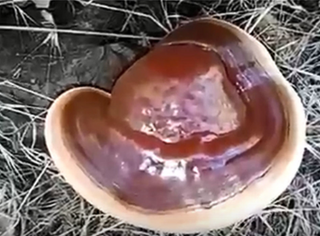
Ganoderma lucidum is a red-colored species of Ganoderma with a limited distribution in Europe and parts of China, where it grows on decaying hardwood trees. Wild populations have been found in the United States in California and Utah but were likely introduced anthropogenically and naturalized.

Fomitopsis pinicola, is a stem decay fungus common on softwood and hardwood trees. Its conk is known as the red-belted conk. The species is common throughout temperate Europe and Asia. It is a decay fungus that serves as a small-scale disturbance agent in coastal rainforest ecosystems. It influences stand structure and succession in temperate rainforests. It performs essential nutrient cycling functions in forests. As well as a key producer of brown rot residues that are stable soil components in coniferous forest ecosystems. It has been reported that mushrooms have significant antioxidant activity.

Quercus variabilis, the Chinese cork oak, is a species of oak in the section Quercus sect. Cerris, native to a wide area of eastern Asia in southern, central, and eastern China, Taiwan, Japan, and Korea.

Ganoderma applanatum is a bracket fungus with a cosmopolitan distribution.

Ganoderma is a genus of polypore fungi in the family Ganodermataceae that includes about 80 species, many from tropical regions. They have a high genetic diversity and are used in traditional Asian medicines. Ganoderma can be differentiated from other polypores because they have a double-walled basidiospore. They may be called shelf mushrooms or bracket fungi.
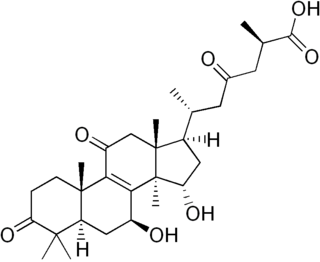
Ganoderic acids are a class of closely related triterpenoids found in Ganoderma mushrooms. For thousands of years, the fruiting bodies of Ganoderma fungi have been used in traditional medicines in East Asia. Consequently, there have been efforts to identify the chemical constituents that may be responsible for the putative pharmacological effects. The two most well described ganoderic acids out of the many that have been identified and characterized are ganoderic acids A and B. Some ganoderic acids have been found to possess biological activities including hepatoprotection, anti-tumor effects, and 5-alpha reductase inhibition.

Rhodofomes cajanderi is a widely distributed species of bracket fungus. Commonly known as the rosy conk due to its rose-colored pore surface, it causes a disease called a brown pocket rot in various conifer species. It is inedible. It is widespread in western North America, with more prevalence in southern climates. It has a particular preference for higher-altitude spruce forests.
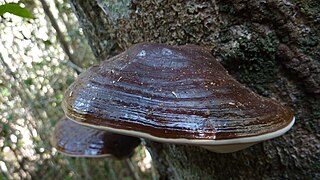
Ganoderma tornatum is a fungal plant pathogen in the genus Ganoderma. It is a species of basidiomycete fungi in the family Polyporaceae. Members are also known as bracket fungi, or polypores.

Ganoderma tsugae, also known as hemlock varnish shelf, is a flat polypore mushroom of the genus Ganoderma.
The phrase "king of herbs" may refer to:

Ganoderma curtisii is a wood-decaying polypore whose distribution is primarily in the Southeastern United States. Craig and Levetin claim to have observed it in Oklahoma.
Medicinal fungi are fungi that contain metabolites or can be induced to produce metabolites through biotechnology to develop prescription drugs. Compounds successfully developed into drugs or under research include antibiotics, anti-cancer drugs, cholesterol and ergosterol synthesis inhibitors, psychotropic drugs, immunosuppressants and fungicides.
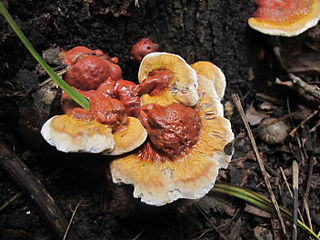
Ganoderma sessile is a species of polypore fungus in the Ganodermataceae family. There is taxonomic uncertainty with this fungus since its circumscription in 1902.
Scytalidium ganodermophthorum is an anthroconidial ascomycete fungus in the Scytalidium genus. It is also known by its teleomorph name Xylogone ganodermophthora. It is the cause of yellow rot in lingzhi mushrooms and it is used in spalting as a pigmenting fungi.

Ganoderma microsporum is a species of Ganoderma mushroom native to Taiwan that grows on willow trees.
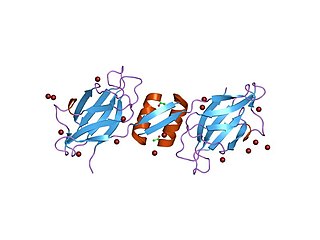
Fungal immunomodulatory proteins (FIPs) are a type of functional compound found in various species of fungi. FIPs are part of the immunoglobulin (ig) family, which are structurally similar to human antibodies, and can interact with human peripheral blood mononuclear cells (PBMCs), causing these cells to secrete different types of hormones and regulate cellular activity.
















